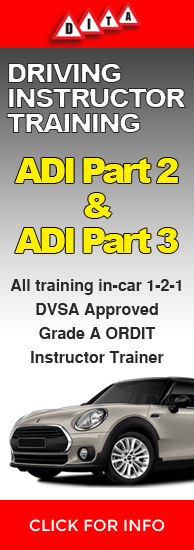ADI Part 2 - Test of Driving Ability

The practical test of driving ability lasts for about one hour and consists of:
- An Eyesight Test
- Safety Questions
- Driving Technique
You are allowed only 3 attempts to pass the part 2 test. If unsuccessful - candidates must wait until 2 years after the date that they passed the theory test before starting the whole process again.
Identification
When you arrive at the test centre you will be expected to show both parts of your photo-card licence. If you have an old-style driving licence you must bring the paper counterpart and your current passport (no other form of photographic identification will be accepted).
The Eyesight Test
You must be able to read in good daylight (with the aid of glasses or contact lenses if worn), a motor vehicle registration plate containing letters and figures:
- 79mm in height and 50mm wide at a distance of 26.5m
- 79mm in height and 57mm wide at a distance of 27.5m
If you don't pass the eyesight test, you will not be allowed to take the driving ability element. The test will be marked as a fail and will count towards your three attempts.
Safety Questions
The examiner will ask you to describe how to perform a check on the condition and safety of three components of the vehicle. You will also be expected to demonstrate an actual check on the condition of a further two components.
The components will be chosen from the following list:
- Tyres
- Steering
- Brakes
- Lights
- Reflectors
- Direction indicators
- Audible warning device
- The liquids used in the braking system, steering system, engine or elsewhere in the vehicle as a coolant, lubricant, cleaner or otherwise
Test of Driving Ability
This is an advanced driving test and a very high standard of competence is required. You must demonstrate a thorough knowledge of the principles of good driving and road safety. You must satisfy the examiner on all or any of the following subjects:
- Expert handling of the controls
- Use of correct road procedure
- Anticipation of the actions of other road users and the taking of appropriate action
- Sound judgement of distance, speed and timing
- Consideration for the convenience and safety of other road users
The routes used for the test will include roads which may carry heavy and/or fast moving traffic; they will also cover a range of road and traffic conditions, including urban and rural conditions.
What do I need to do in order to pass?
You must show the ability to perform any or all of the following manoeuvres including all three of the reversing exercises:
- Move away straight ahead or at an angle
- Overtake, meet or cross the path of other vehicles and take an appropriate course without undue hesitancy
- Turn left-hand and right-hand corners correctly without undue hesitancy
- Stop the vehicle in an emergency
- Drive the vehicle in reverse gear and whilst doing so enter limited openings to the right and to the left, taking effective all round observation
- Turn the vehicle to face in the opposite direction by the use of forward and reverse gears taking effective all-round observation
- Reverse park the vehicle into the space behind a parked car, within the space of about two car lengths and close to and parallel with the kerb,
taking effective all round observation
or
Reverse park into a parking bay, with due regard for other vehicles or pedestrians, while taking effective all-round observation
The Test Vehicle
It is your responsibility to provide a legally roadworthy car:
- It must be properly taxed and insured
- It must be a saloon car or hatchback/estate car in good working condition
- It must have seat belts in working order
- It must be capable of the normal performance of vehicles of its type with a manual transmission
- It must have Right-Hand steering
- It must have a readily adjustable seat with a head restraint for a forward facing front passenger
- The car must not display L plates
- You also need an adjustable interior rear view mirror for use by the examiner
If your vehicle does not meet the above requirements, it will not be possible to carry out the test.
Remember to ask your Training College whether they supply a car to use on this test and whether there is a charge for the hire of the vehicle.
This is NOT simply a stepping stone onto the next part...
This element of the qualification process is critical to the Part 3 Test. The standard of driving becomes a model from which you teach. You will need to be able to draw on the experience you gain here to teach others to drive to your level.
